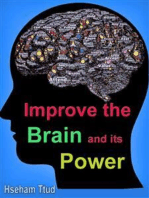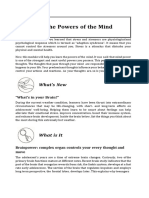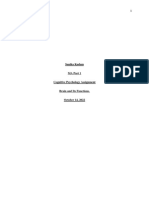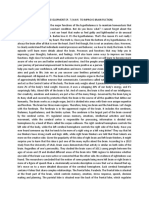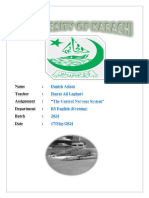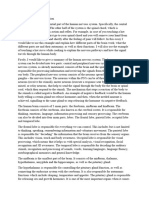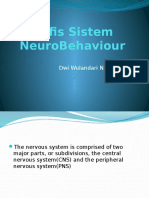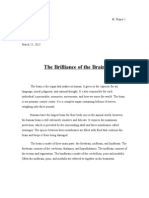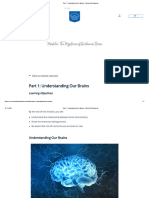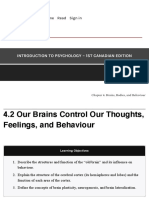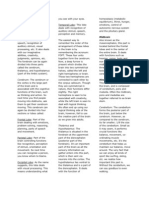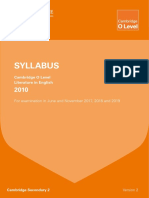Brain and Mind
Brain and Mind
Uploaded by
Mubashir AminCopyright:
Available Formats
Brain and Mind
Brain and Mind
Uploaded by
Mubashir AminOriginal Description:
Copyright
Available Formats
Share this document
Did you find this document useful?
Is this content inappropriate?
Copyright:
Available Formats
Brain and Mind
Brain and Mind
Uploaded by
Mubashir AminCopyright:
Available Formats
10/1/2014
Psycholinguistics
Brain & Mind
Psycholinguistics | Mubashir Amin
1
Brain -------- What is Brain?
The brain is an organ that serves as the center of the nervous system; everything you are and
everything you do is controlled by your brain. It is located in the head and about 1400 grams of pinkish-
white matter. The brain is the most complex organ of the body. It is composed of nerve cells or neurons
that are the basic information processing units of the nervous system. The human brain contains about
ten billion neurons that are organized into networks of almost unimaginable complexity. It is such an
imperceptible complexity, in which each neuron is linked with thousands of other neurons. It is
believed that each individual neuron network connects with approximately 1,100 other neurons.
Neuroscientists estimate that there are over 12 billion neurons in the brain. It is not only a mass of
interconnected neurons but also a composition based on different structures that are bound to play
specific roles in the integrated functioning of the brain. We can think of the brain as a very large network
of different communication centers that can flash on and off and send messages to one another
through electrical impulses. The brain contains many different specialized information centers
scattered throughout its three-dimensional space. These highly specialized areas of gray matter are
centers or way stations that contain the ability to remember, to formulate decisions, and to issue
commands.
Different areas of gray matter are specialized in different functions, such as moving, seeing, touching,
listening, thinking, or modulating physical functions. These specialized areas of gray matter are
connected to one another through fibers that are like wires; these fiber tracks are the material that we
see in the brain as white matter.
When communication between the centers in the brain breaks down, it may be due either to direct
damage to a center of gray matter or to damage to the wiring between the centers. The brain has an
amazing adaptive capacity that is sometimes referred to as "plasticity" - when damage occurs,
messages can be sent through alternate connections.
As far as the difference between the brain and the mind is concerned, it (the brain) is considered and
treated like a hardware.
Mind -------- What is Mind?
(Will be discussing under the heading of difference between the brain and the mind as well.)
Where there we say that the brain is a hardware, there we also can say that mind is a software.
In order to begin a precise investigation on the topic of the mind, we must first separate from the
traditional thinking that the brain and the mind acts as one.
When one says the term "mind we immediately responds with the idea of the brain. The brain is the
essence to a functional body; the mind however, is the essence of what it means to be human. The
mind can never be pictured; it is an area within one's self where a higher level of contemplation occurs.
The brain however is a visible object. Its function is similar to that of a car engine. It runs the physical
processes of the body, such as movement, or producing the feeling of thirst. When we are thirsty the
brain gets the message and then reacts by telling the body that it needs water. This message arrives
at the brain only through the mind. The brain is not capable of contemplating such ideas as thirst.
Psycholinguistics | Mubashir Amin
2
However, the brain and the mind are in one package. So, where in the brain's hardware is the mind
found? Supposedly it is found in the frontal lobe of the brain. The frontal lobe is involved in paying
attention, planning, behaving emotionally, interacting socially, making decisions and organizing plans.
The relationship between the mind and the brain are one, but different. The brain is the physical part
of the mind and the mind is the neurologically part of the brain. The brain is the portion of the vertebrate
central nervous system that is enclosed within the cranium, continuous with the spinal cord, and
composed of gray matter and white matter. It is primary center for the regulation and control of bodily
activities, receiving and interpreting, sensory impulses, and transmitting information muscles to body
organism.
However, the mind is the human consciousness that originates in the brain and is manifested
especially in thought, emotion, will, memory, and imagination. It is also the faculty of thinking,
reasoning, and applying knowledge. The relationship between the mind and the brain are connected
in every way you perceive it. So without the brain, there would not be such thing called the mind.
Functions of the brain -------- What does the brain do?
(Will be discussed under the heading of the brain structure; and this heading will also cover Hemispheres and their
functions successively.)
The brain is the control center for all the bodys functions, such as walking, talking, swallowing,
breathing, taste, smell, heart rate and so on. It also controls all our thinking functions, our emotions,
how we behave and all our intellectual (cognitive) activities, such as how we attend to things, how we
perceive and understand our world and its physical surroundings, how we learn and remember and
so on.
Damage to a particular part of the brain can produce impairment in the function that it controls. If the
damage is limited to a small area, then it is likely that only a few functions will be impaired. If, however,
as is more common, there is widespread damage, then this can produce a complex array of physical
and psychological problems. The level of impairment will depend on the type, location and severity of
the injury.
There are three main parts that play a vital part in our ability to function:
1. The Cerebral Cortex
2. The Brain Stem
3. The Cerebellum
The Cerebral Cortex
The cerebral cortex is the largest part of the brain and is the area that is responsible for all our thinking
activities. The cortex is a grey wrinkled mass that sits like a cap over the rest of the brain. The wrinkle
appearance results from the cortex being folded in upon itself. It has been estimated that up to 65 per
cent of the cortex is hidden within its folds. It is within the human cortex that the secrets of language
representation and processing are to be found. It is divided into two connected halves the left and
right cerebral hemispheres.
Psycholinguistics | Mubashir Amin
3
The left hemisphere controls the right side of the body and the right hemisphere controls the left.
For example, if a person sustains a brain injury, such as a stroke, to the left hemisphere in the area of
the cerebral cortex that controls movement, this may result in weakness or even paralysis of the right
arm and leg.
In most people, the left hemisphere primarily controls verbal functions such as speech and language
while the right hemisphere primarily controls visual spatial (non-verbal) functions such as those
involved in drawing, rhythm or finding ones way in unfamiliar surroundings. The hemispheres are
known to process material in different ways with the left cerebral hemisphere specializing in processing
material in a sequential and logical manner and the right cerebral hemisphere processing information
in a holistic and intuitive way.
The cerebral cortex is further divided into four areas, or lobes:
1. The Frontal Lobes
2. The Temporal Lobe
3. The Parietal Lobe
4. The Occipital Lobe
Each lobe of the brain controls specific functions and skills.
1. The frontal lobe
The frontal lobe has been termed the executive of the brain. This is where all of our higher-level
thinking goes on. It allows us to:
- Reason logically
- Make decisions
- Plan and organize
- Problem-solve
- Exercise good judgment
- Monitor or manage our actions
It is considered to be the home of our personality and the control center for our emotions and behavior.
The frontal lobes allow us to apply our knowledge and adapt our behavior so that it is appropriate to
the situation we are in. The frontal lobes also contain the motor cortex, a vital part of the brain system
controlling movement.
The frontal lobe is extremely vulnerable to injury due to their position at the front of the skull. Studies
have found that the frontal area is the most common region of injury, even following mild brain injury.
Damage to this area can cause myriad cognitive problems and can dramatically change social
behavior and personality. Physical problems can include the loss of fine movements, lack of strength
in the arms, hands and fingers, little spontaneous facial expression or difficulty in speaking.
2. The temporal lobe
The temporal lobe lies just behind our ears and contains the auditory cortex. This allows us to interpret
sound. The temporal lobe stores most of our memories and is involved in aspects of language,
including our ability to use language and understand what we hear.
Like the frontal lobes, the temporal lobe is involved in regulating certain aspects of personality. Deep
inside the temporal lobe are the structures of the hypothalamus and limbic system. The hypothalamus
is involved in instinctual behaviors such as aggression, sexual arousal, appetite, thirst and temperature
control. The limbic system is in control of emotional reactions.
Psycholinguistics | Mubashir Amin
4
Damage to these areas can severely disrupt our emotions resulting in sudden and dramatic mood
swings; and can also lead to inappropriate social behavior such as hyper-sexuality and impulsiveness.
3. The parietal lobe
The parietal lobe contains the somatosensory cortex which receives and analyses information from
the skin concerning touch, pressure, temperature and some aspects of pain.
The parietal lobe is vital to our spatial understanding of the world. For example, it enables us to
understand where we are in relation to our surroundings and where our body parts are in relation to
each other, as well as the spatial relationships between the things we perceive in our environment.
Damage to the parietal lobe can impair reading, writing and mathematical abilities, drawing and
constructional tasks, as well as self-care abilities such as washing and dressing.
4. The occipital lobe
The occipital lobe analyses what we see and is, therefore, responsible for sight. If it is damaged,
blindness or partial blindness can result.
..
You might also like
- MCQ Preprosth SurgeryDocument5 pagesMCQ Preprosth SurgeryKhaled Atef Elhayes67% (24)
- Water Seal DrainageDocument6 pagesWater Seal DrainageAmit MartinNo ratings yet
- Airway ManagementDocument13 pagesAirway ManagementAlaa DaoudNo ratings yet
- Brain Health - How to Have a Healthy Memory and a Healthy BrainFrom EverandBrain Health - How to Have a Healthy Memory and a Healthy BrainNo ratings yet
- 3B The Brain: Unit Questions: Mia Ramos Block-2Document2 pages3B The Brain: Unit Questions: Mia Ramos Block-2api-296059071No ratings yet
- Perdev Mod 5 Powers of The MindDocument14 pagesPerdev Mod 5 Powers of The MindHanimla OsapmaNo ratings yet
- Cognitive Development ModuleDocument20 pagesCognitive Development ModuleMaria Mendoza AlejandriaNo ratings yet
- Chapter 8 The Mental SelfDocument12 pagesChapter 8 The Mental Selfbulcasejohn21No ratings yet
- The Power To ActDocument38 pagesThe Power To ActRed Lopez100% (1)
- Learning Activity Sheets - Perssonal DevelopmentDocument6 pagesLearning Activity Sheets - Perssonal DevelopmentLyncel FayeNo ratings yet
- PerDev Powers of The Mind Lesson ActivitiesDocument9 pagesPerDev Powers of The Mind Lesson Activitieskath santiagoNo ratings yet
- CognitiveDocument6 pagesCognitivesanika kadamNo ratings yet
- Super Brain: Strategies to Upgrade Your Brain, Unlock Your Potential, Perform at Your Peak, and Achieve AnythingFrom EverandSuper Brain: Strategies to Upgrade Your Brain, Unlock Your Potential, Perform at Your Peak, and Achieve AnythingNo ratings yet
- Personal Development EpDocument3 pagesPersonal Development Epkristine angela baldestamonNo ratings yet
- Dementia and The BrainDocument13 pagesDementia and The BrainLuminita AndreiNo ratings yet
- Mind and Behavior 1Document23 pagesMind and Behavior 1Yara El-GhadbanNo ratings yet
- Hular, Diane S. Physiological Psychology: Reaction Paper On Nervous SystemDocument2 pagesHular, Diane S. Physiological Psychology: Reaction Paper On Nervous SystemViola HastingsNo ratings yet
- CerebrumDocument8 pagesCerebrumBeing AhsanNo ratings yet
- PsychologyDocument8 pagesPsychologyDanish AslamNo ratings yet
- Document 6Document16 pagesDocument 6Vaneeza AliNo ratings yet
- Brain Enhancement. How to Optimize Your Brain for a Fuller Life.From EverandBrain Enhancement. How to Optimize Your Brain for a Fuller Life.No ratings yet
- Brain Structure and FunctionDocument5 pagesBrain Structure and Functionmademoiselle in transitNo ratings yet
- Preparation in Psychology: Bicol University College of Engineering East Campus LegazpiDocument8 pagesPreparation in Psychology: Bicol University College of Engineering East Campus LegazpiKielNo ratings yet
- Introduction To BrainDocument3 pagesIntroduction To BrainrgdevikaNo ratings yet
- Hypnotic Language BootcampDocument200 pagesHypnotic Language BootcampAidil100% (7)
- The Powers of The MindDocument2 pagesThe Powers of The MindErron Francisco NicolNo ratings yet
- Lesson 6 POWERS of The MINDDocument25 pagesLesson 6 POWERS of The MINDRham RhumNo ratings yet
- Brain Structure (Studying 2)Document2 pagesBrain Structure (Studying 2)nnotBlueNo ratings yet
- Brain Parts and FunctionDocument6 pagesBrain Parts and FunctionChabbigillNo ratings yet
- The BrainDocument28 pagesThe BrainAnania EmmanuelNo ratings yet
- Brain Basics - Know Your Brain - National Institute of Neurological Disorders and StrokeDocument4 pagesBrain Basics - Know Your Brain - National Institute of Neurological Disorders and Strokesurajit halderNo ratings yet
- What Comprises A Brain?Document2 pagesWhat Comprises A Brain?NataliaLizcanoNo ratings yet
- Brain Structures and Their Functions PDFDocument26 pagesBrain Structures and Their Functions PDFNur Nashran Mahran100% (4)
- The MindDocument3 pagesThe MindWiam MardianaNo ratings yet
- Science 6 Oct19 22 - Nervous System Part 1Document8 pagesScience 6 Oct19 22 - Nervous System Part 1Pardeep DhillonNo ratings yet
- BrainDocument15 pagesBrainŞterbeţ RuxandraNo ratings yet
- Structure PhysiologyDocument8 pagesStructure PhysiologyfatehahNo ratings yet
- Anfis Sistem NeuroBehaviourDocument37 pagesAnfis Sistem NeuroBehaviourDediSunartoNo ratings yet
- ABPG1103 - Topic 2 - Biological Psychology - 222Document31 pagesABPG1103 - Topic 2 - Biological Psychology - 222nureryani bathowiNo ratings yet
- Chapter 1 ReadingDocument4 pagesChapter 1 ReadingYousef Ahmad2No ratings yet
- The Brilliance of The BrainDocument5 pagesThe Brilliance of The Brainapi-219083677No ratings yet
- Structure of BrainDocument24 pagesStructure of Brainhajiwaheed0604No ratings yet
- Part 1 - Understanding Our Brains - Centre of ExcellenceDocument7 pagesPart 1 - Understanding Our Brains - Centre of ExcellencedanielaamazonNo ratings yet
- Week 2 - HSO207Document23 pagesWeek 2 - HSO207eliza.tolfreyNo ratings yet
- The BrainDocument12 pagesThe BrainSaadNo ratings yet
- Brain & BehaviourDocument11 pagesBrain & Behaviourtekhminafareed12No ratings yet
- The Human BrainDocument6 pagesThe Human BraindamanzurNo ratings yet
- โท the BrainDocument39 pagesโท the BrainFadil Wanna-mart100% (1)
- Human BrainDocument13 pagesHuman BrainAaniya AsadNo ratings yet
- Neuroscience in The Workplace How Understanding The Brain Can Transform Your Business e BookDocument34 pagesNeuroscience in The Workplace How Understanding The Brain Can Transform Your Business e BookHarish C NNo ratings yet
- 1 BrainDocument2 pages1 BrainJonance YeeNo ratings yet
- 4.2 Our Brains Control Our Thoughts, Feelings, and BehaviourDocument18 pages4.2 Our Brains Control Our Thoughts, Feelings, and BehaviouradelaNo ratings yet
- Personal Development Week 7-8Document10 pagesPersonal Development Week 7-8Edilene Rosallosa CruzatNo ratings yet
- 1.7 What Does The Brain DoDocument3 pages1.7 What Does The Brain DoStella StaryNo ratings yet
- Fore BrainDocument3 pagesFore BrainAngela EndayaNo ratings yet
- 2-Learning To Live in Cheon Il Guk - Lesssons Fron Brain ResearchDocument19 pages2-Learning To Live in Cheon Il Guk - Lesssons Fron Brain ResearchFirmino de Oliveira FialhoNo ratings yet
- Muscle Memory-1 (Completed)Document54 pagesMuscle Memory-1 (Completed)Ejiofor William ChinonsoNo ratings yet
- Module 3 - Facilitating Learner - Centered TeachingDocument6 pagesModule 3 - Facilitating Learner - Centered TeachingSheila Mae Paltep100% (2)
- Brain System: Parts and FunctionsDocument9 pagesBrain System: Parts and FunctionsChristhoper John Dela CruzNo ratings yet
- PsychologyDocument6 pagesPsychologymahbinaalone7No ratings yet
- Human BrainDocument12 pagesHuman BrainJashwanthNo ratings yet
- O-Level English LiteratureDocument20 pagesO-Level English LiteratureMubashir Amin100% (1)
- Ancient PhilosophyDocument145 pagesAncient PhilosophyMubashir AminNo ratings yet
- Influence of Islam On Indian CultureDocument759 pagesInfluence of Islam On Indian CultureMubashir AminNo ratings yet
- Instructional Technology vs. Educational Technology: by K. HallDocument8 pagesInstructional Technology vs. Educational Technology: by K. HallMubashir AminNo ratings yet
- Pragmatic Approach and The Choice of MethodsDocument18 pagesPragmatic Approach and The Choice of MethodsMubashir AminNo ratings yet
- Curriculum, History and TypesDocument14 pagesCurriculum, History and TypesMubashir AminNo ratings yet
- Thesis Setup Error PelvicDocument43 pagesThesis Setup Error PelvichandiaviNo ratings yet
- Case Presentation TATDocument28 pagesCase Presentation TATDrTATNo ratings yet
- GHB Conversion Chart 28 08 09-V-BDocument1 pageGHB Conversion Chart 28 08 09-V-Bshar12100% (1)
- English IX, Unit 10 Drug AddictionDocument2 pagesEnglish IX, Unit 10 Drug AddictionJavaid HussainNo ratings yet
- Cardiac Output (Q) - : Adaptations To Aerobic Training ProgramsDocument4 pagesCardiac Output (Q) - : Adaptations To Aerobic Training ProgramsStefan LucianNo ratings yet
- Ernestine WiedenbachDocument7 pagesErnestine WiedenbachSimon ArchibaldNo ratings yet
- FCSorth Regulations & Syllabus 2016 - 0Document10 pagesFCSorth Regulations & Syllabus 2016 - 0Ian OrwaNo ratings yet
- Genetik Konseling Pada PJBDocument26 pagesGenetik Konseling Pada PJBbobkevinNo ratings yet
- Concept Map On Renal FailureDocument1 pageConcept Map On Renal FailureJessilda Damian VeranoNo ratings yet
- Non Hodgkin LymphomaDocument37 pagesNon Hodgkin LymphomaYulanda Gusti Cibi100% (1)
- European Strategic Directions Strengthening Nursing Midwifery Health2020 en REV1Document35 pagesEuropean Strategic Directions Strengthening Nursing Midwifery Health2020 en REV1Catalina StoicescuNo ratings yet
- MWD 2450PDocument19 pagesMWD 2450PRistica Tyas SuryaNo ratings yet
- ALF Functional ApplianceDocument4 pagesALF Functional ApplianceValonia IreneNo ratings yet
- Melanoma Skin Cancer Early Detection, Diagnosis, and StagingDocument21 pagesMelanoma Skin Cancer Early Detection, Diagnosis, and StagingKristine YoungNo ratings yet
- Prosthetics A System of DesignDocument6 pagesProsthetics A System of DesignParidhi GargNo ratings yet
- Shamar Litvinoff ResumeDocument1 pageShamar Litvinoff Resumeapi-437400259No ratings yet
- Microbiology-ELISA Testing Lab ReportDocument2 pagesMicrobiology-ELISA Testing Lab Reportsaraebo33% (3)
- DSM 5 Cult PDFDocument62 pagesDSM 5 Cult PDFChristian VladNo ratings yet
- RS85 V1.0 Catalog 171204 Spread LowDocument8 pagesRS85 V1.0 Catalog 171204 Spread LowEmrah SeverNo ratings yet
- Pap Smear TestDocument27 pagesPap Smear Testiangould12No ratings yet
- Antiepileptic Drugs Continuum 2016Document25 pagesAntiepileptic Drugs Continuum 2016Habib G. Moutran BarrosoNo ratings yet
- 9789513944360Document146 pages9789513944360Roar SyltebøNo ratings yet
- Monthly Journal.Document4 pagesMonthly Journal.Aday Graceey MinozaNo ratings yet
- RJPDocument72 pagesRJPFembriya Tenny UtamiNo ratings yet
- How Art Therapy For Children Can HelpDocument9 pagesHow Art Therapy For Children Can HelpMariana Anab100% (1)
- 001 or Nursing SupervisorDocument5 pages001 or Nursing SupervisorAeryll JasminNo ratings yet
- EuthanasiaDocument16 pagesEuthanasiaDale GallegosNo ratings yet







